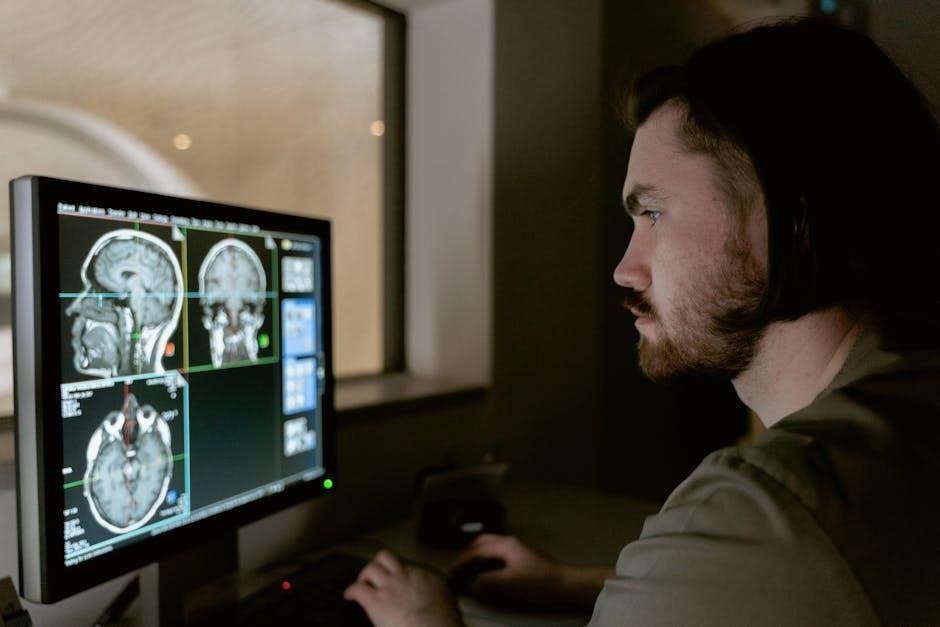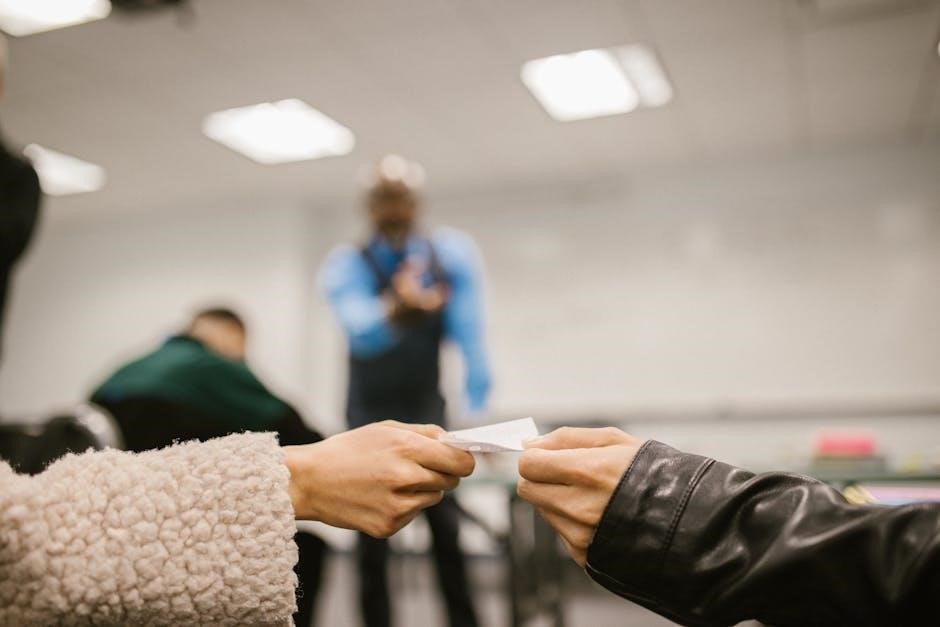Welcome to the firefighter test study guide! This comprehensive resource is designed to help you prepare for the challenging firefighter exam and selection process․ Covering key areas like the physical ability test, written exam, and medical assessments, this guide provides essential strategies for success․
1․1․ Understanding the Importance of the Firefighter Exam
The firefighter exam is a critical step in becoming a firefighter, as it evaluates candidates’ physical, mental, and emotional readiness for the job․ The exam ensures candidates can handle the demands of firefighting, including emergency response, physical challenges, and high-pressure decision-making․ Passing the exam demonstrates a candidate’s ability to learn firefighting procedures, operate equipment, and work effectively in a team․ A high score can improve eligibility and ranking for job placement․ The exam also reflects real-life scenarios, ensuring firefighters are prepared to protect lives and property․ Preparing thoroughly is essential, as failure to meet standards can disqualify candidates․
1․2․ Overview of the Firefighter Selection Process
The firefighter selection process is a rigorous, multi-step evaluation designed to identify highly qualified candidates․ It typically begins with a written exam assessing knowledge and cognitive skills, followed by a physical ability test (PAT) to measure strength, endurance, and agility․ Candidates must also undergo medical and psychological evaluations to ensure they meet the physical and mental demands of the job․ Additionally, an oral interview and background check are conducted to evaluate character, communication skills, and personal history․ Each step is carefully designed to assess a candidate’s suitability for firefighting, ensuring only the most capable individuals advance to training and employment․

Physical Ability Test (PAT)
The Physical Ability Test (PAT) evaluates a candidate’s strength, endurance, and agility․ It includes tasks like ladder climbing, stair climbs, and equipment carrying, simulating firefighting scenarios․
2․1․ Overview of the Candidate Physical Ability Test (CPAT)
The Candidate Physical Ability Test (CPAT) is a standardized assessment evaluating physical skills essential for firefighting․ It includes tasks like ladder raises, stair climbs, and equipment carries, simulating real-world firefighting scenarios․ Candidates must wear a 50-pound vest during the test, which is designed to mimic the weight of firefighting gear․ The test is pass/fail, with a maximum completion time of 10 minutes and 20 seconds․ Orientation sessions and practice tests are mandatory, allowing candidates to familiarize themselves with the course layout and requirements․ The CPAT is a critical component of the firefighter selection process, ensuring candidates possess the physical endurance, strength, and agility needed for the job․
2․2․ Key Components of the Physical Ability Test
The Physical Ability Test (PAT) evaluates essential firefighting skills through specific tasks․ Key components include the ladder raise, stair climb, forcible entry, hose drag, equipment carry, and rescue․ Each task simulates real firefighting scenarios, assessing strength, endurance, and agility․ The ladder raise tests upper body strength, while the stair climb evaluates cardiovascular stamina․ Forcible entry measures power and technique, and the hose drag assesses grip strength and coordination․ The equipment carry and rescue simulate carrying heavy gear and rescuing victims, requiring teamwork and agility․ These components ensure candidates can perform physically demanding tasks safely and efficiently, reflecting the challenges of firefighting․ Proper preparation is crucial to excel in each area․
2․3․ Preparation Tips for the Physical Ability Test
Preparing for the Physical Ability Test (PAT) requires a structured approach to build strength, endurance, and agility․ Start with a workout plan that includes cardiovascular exercises, weight training, and functional movements․ Focus on simulating test conditions, such as wearing a weighted vest during practice to mimic the 50-pound gear․ Incorporate exercises like squats, lunges, and stair climbing to target key muscle groups․ Practice carrying heavy objects and dragging hoses to improve grip and coordination․ Ensure proper hydration and nutrition to fuel your workouts․ Rest and recovery are equally important to avoid injury․ Consider enrolling in CPAT orientation sessions for hands-on experience and guidance․ Stay consistent and gradually increase intensity to peak performance on test day․

Written Examination
Master the written exam with a focus on fire safety, emergency procedures, and problem-solving․ Practice multiple-choice questions to enhance accuracy and time management skills effectively․
3․1․ Structure and Format of the Firefighter Written Exam
The firefighter written exam typically consists of multiple-choice questions, assessing knowledge in areas like fire safety, emergency protocols, and situational judgment․ Tests often include 100-150 questions, with a time limit․ Some exams feature scenario-based questions to evaluate decision-making skills․ The format may vary by department, but generally, it’s divided into sections testing technical knowledge and problem-solving abilities․ Preparation guides and practice tests are recommended to familiarize oneself with the structure and content․ Scoring is based on accuracy, with a minimum passing score typically around 75%․ Proper time management and focused study are crucial for success․
3․2․ Common Topics Covered in the Written Test
The firefighter written exam covers a wide range of topics to assess both technical knowledge and practical skills․ Key areas include fire safety principles, emergency response protocols, and situational judgment․ Questions often focus on fire dynamics, hazardous materials, and equipment operation․ Additionally, topics like communication skills, teamwork, and ethical decision-making are frequently included․ Basic arithmetic and problem-solving scenarios are also common, as they evaluate critical thinking under pressure․ Understanding local fire codes and safety regulations is another critical area․ The exam may also include questions on first aid and medical emergencies, ensuring candidates are well-rounded in their knowledge and prepared for real-world challenges․
3․3․ Strategies for Scoring High on the Written Exam
To excel on the firefighter written exam, focus on thorough preparation and strategic test-taking techniques․ Utilize official study guides and practice tests to familiarize yourself with the format and content․ Allocate dedicated time for each section to ensure efficient time management․ Prioritize high-weight topics like fire safety protocols and emergency response procedures․ Elimination techniques can help narrow down multiple-choice answers effectively․ Practice under timed conditions to build endurance and accuracy․ Reviewing mistakes from practice tests is crucial for improvement․ Stay calm, read questions carefully, and aim for consistent progress․ By combining knowledge retention with smart test strategies, you can achieve a high score and advance in the selection process․

Firefighter Exam Preparation Strategies
Effective preparation involves creating a structured study plan, utilizing official guides, and practicing consistently․ Regular review of mistakes and staying organized are key to success․
4․1․ Time Management and Study Schedules
Effective time management is crucial for success in the firefighter exam․ Create a detailed study schedule, allocating specific times for physical training, written exam preparation, and rest․ Prioritize tasks based on exam components, ensuring a balance between physical and academic preparation․ Regularly review progress to stay on track and adjust the schedule as needed․ Consistency is key to building both mental and physical stamina․ By adhering to a structured plan, candidates can efficiently cover all necessary material and perform optimally on exam day․
4․2․ Recommended Study Materials and Resources
To excel in the firefighter exam, utilize high-quality study materials tailored to the test format․ Official study guides and practice tests are essential for familiarizing yourself with the exam structure․ For the physical ability test, focus on materials detailing the CPAT or similar assessments․ Written exam resources should cover firefighting procedures, safety protocols, and situational judgment questions․ Online platforms offering simulated tests and video tutorials can enhance preparation․ Additionally, consult firefighter training manuals and attend CPAT orientation sessions for hands-on experience․ Leveraging these resources ensures a well-rounded and effective study approach, boosting confidence and performance․
4․3․ Importance of Practice Tests and Mock Exams
Practice tests and mock exams are cornerstone elements in preparing for the firefighter exam․ They provide a realistic simulation of the actual test environment, helping candidates assess their readiness and identify weak areas․ Regular practice builds familiarity with the exam format, question types, and time constraints․ Mock exams also enhance problem-solving speed and accuracy, crucial for both written and physical assessments․ Furthermore, these tools allow candidates to refine their strategies under timed conditions, reducing anxiety and improving overall performance․ Consistent use of practice tests ensures a polished and confident approach, significantly increasing the likelihood of success in the challenging firefighter selection process․

Medical Assessment and Requirements
The medical assessment ensures candidates meet rigorous health standards for firefighting․ It includes vision tests, physical evaluations, and screenings to confirm overall fitness for the demanding role․
5․1․ Medical Evaluation Process for Firefighters
The medical evaluation process for firefighters is thorough, ensuring candidates meet strict health standards․ It begins with a review of medical history, followed by vision, hearing, blood pressure, and lung function tests․ Additionally, blood and urine analyses are conducted to check for underlying conditions․ Candidates must also undergo physical examinations to assess cardiovascular health and muscular-skeletal fitness․ The process may include stress tests and comprehensive medical questionnaires․ All evaluations are designed to confirm that candidates can safely perform firefighting duties without risking their health or the safety of others․ This step is crucial for ensuring readiness for the physical demands of the job․
5․2․ Common Medical Tests and Screenings
Common medical tests for firefighters include vision and hearing assessments, blood pressure checks, and lung function tests to ensure respiratory health․ Blood and urine analyses detect potential health issues, while stress tests evaluate cardiovascular fitness․ Candidates undergo physical exams focusing on muscular-skeletal strength and flexibility․ Comprehensive medical questionnaires are reviewed to identify pre-existing conditions․ These screenings ensure that candidates can safely perform demanding tasks without health risks, aligning with the rigorous requirements of firefighting․ Each test is critical for confirming overall fitness and ability to handle the job’s physical and mental challenges effectively․
5․3․ How to Prepare for the Medical Assessment
To prepare for the medical assessment, maintain a healthy lifestyle by eating a balanced diet, staying hydrated, and exercising regularly․ Avoid smoking and limit alcohol consumption, as these can negatively impact test results․ Ensure you get adequate sleep and manage stress to support overall well-being․ Familiarize yourself with the types of tests, such as blood pressure checks and lung function tests, to reduce anxiety․ Avoid caffeine and heavy meals on test day, and arrive well-rested․ Review your medical history and disclose any conditions honestly․ Follow all instructions provided by the medical team to ensure accurate results and a smooth process․

Psychological Evaluation
The psychological evaluation assesses your mental fitness for firefighting, focusing on traits like courage, decision-making, and teamwork․ It ensures you can handle high-stress situations effectively and remain composed under pressure․
6․1․ Purpose and Structure of the Psychological Test
The psychological test evaluates a candidate’s mental suitability for firefighting, assessing traits like courage, decision-making, and teamwork․ It ensures individuals can manage high-stress environments and maintain composure․ The test typically includes multiple-choice questions and scenario-based assessments, designed to measure emotional stability, problem-solving skills, and leadership potential․ Standardized tools like the MMPI or NEO-PI may be used․ Results help determine if a candidate possesses the psychological resilience and aptitude required for the demanding role of a firefighter․ This evaluation is a critical step in ensuring that only those mentally prepared for the challenges of firefighting advance in the selection process․
6․2․ Common Question Types in the Psychological Exam
The psychological exam for firefighters includes various question types to assess mental fitness․ Personality assessments evaluate traits like courage and teamwork․ Situational judgment questions present fire-related scenarios to test decision-making․ Emotional stability is measured through questions about stress management․ Some exams include cognitive ability tests to gauge problem-solving skills․ Moral reasoning questions assess ethical decision-making․ All questions aim to identify candidates who can handle the mental demands of firefighting․ These exams ensure only those with the right psychological profile advance, aligning with the high-stress nature of the job․ Preparation is key to performing well in this critical evaluation․
6․3․ Tips for Performing Well on the Psychological Test
To excel on the psychological exam, practice with sample questions to familiarize yourself with the format․ Stay calm and read questions carefully to avoid misunderstandings․ Be honest in your responses, as the test aims to assess your suitability for firefighting․ Focus on showcasing traits like teamwork, decision-making, and emotional stability․ Reviewing past experiences can help you articulate your reactions to stressful situations․ Understanding the test’s purpose and structure beforehand can reduce anxiety․ Lastly, ensure you are well-rested and mentally prepared on exam day to perform at your best․

Oral Interview and Communication Skills
The oral interview assesses your communication skills, confidence, and suitability for firefighting roles․ Practice answering common questions clearly and professionally, showcasing teamwork and leadership abilities․
7․1․ Importance of the Oral Interview in the Selection Process
The oral interview is a critical component of the firefighter selection process, evaluating communication skills, confidence, and decision-making abilities․ It allows hiring panels to assess personal qualities that cannot be measured by written exams or physical tests․ Demonstrating leadership, teamwork, and problem-solving skills during the interview significantly impacts your candidacy․ Preparation is key, as it showcases professionalism and readiness for the demands of firefighting․ A strong performance can distinguish you from other candidates, making the oral interview a pivotal moment in securing a position as a firefighter․
7․2․ Common Questions Asked in Firefighter Interviews
Common questions in firefighter interviews often focus on assessing your motivation, teamwork, and problem-solving skills․ Expect questions like, “Why do you want to become a firefighter?” or “Describe a time you worked under pressure․” Interviewers may also ask scenario-based questions, such as how you would handle a difficult teammate or make quick decisions in emergencies․ Additionally, questions about your physical fitness, willingness to learn, and adaptability are frequent․ Being prepared to provide specific examples from your experiences and clearly articulating your thought process is crucial for a strong performance․ Practice answering behavioral and situational questions to build confidence and clarity․
7․3․ Techniques to Improve Communication Skills
Improving communication skills is vital for success in firefighter interviews and teamwork․ Practice active listening by maintaining eye contact and asking clarifying questions․ Develop clear and concise speech by organizing your thoughts before responding․ Boost confidence by preparing for common questions and practicing your delivery; Role-playing scenarios with a partner can also enhance your ability to articulate ideas effectively․ Additionally, focus on staying calm under pressure by taking deep breaths and speaking at a steady pace․ These techniques will help you convey your ideas clearly and professionally, making you a more compelling candidate during the selection process․

Background Check and Character Assessment
A background check and character assessment are critical steps in the firefighter selection process․ They ensure candidates have a clean criminal history, stable employment record, and strong moral character, essential for public trust and safety․
8․1․ What to Expect During the Background Investigation
During the background investigation, candidates undergo a thorough review of their personal history․ This includes criminal records, employment history, credit checks, and verification of educational credentials․ Investigators may also interview friends, family, and previous employers to assess character and integrity․ Any discrepancies or issues, such as felony convictions or dishonesty, can disqualify a candidate․ It is crucial to ensure all information provided is accurate and truthful․ The process aims to evaluate trustworthiness and suitability for a role requiring public trust and high ethical standards․ A clean and positive background is essential for advancing in the firefighter selection process․
8․2․ How to Ensure a Clean and Positive Background
To ensure a clean and positive background, maintain honesty and transparency throughout the application process․ Avoid illegal activities, resolve any legal issues promptly, and ensure all criminal records are clear․ Build a reputable work history by being reliable and professional․ Address credit issues and maintain good financial standing․ Avoid associations with individuals or groups that could raise concerns․ Volunteer and engage in community activities to demonstrate positive character․ Disclose all required information accurately to avoid disqualification․ A clean background not only strengthens your candidacy but also reflects the high ethical standards expected of firefighters․ Proactive efforts now can significantly improve your chances of success․

Candidate Physical Ability Test (CPAT) Practice
Attending CPAT orientation sessions and practice tests is crucial for understanding the exam format and improving performance․ Regular practice helps build stamina and familiarize you with test-specific tasks․
9․1․ Benefits of Attending CPAT Orientation Sessions
Attending CPAT orientation sessions provides candidates with a clear understanding of the test components, ensuring they are well-prepared․ These sessions explain the exam format, safety protocols, and scoring criteria, reducing anxiety․ They also offer hands-on exposure to equipment and tasks, allowing candidates to practice under supervision․ This practical experience helps identify strengths and areas for improvement․ Additionally, orientation sessions provide an opportunity to ask questions and receive expert guidance․ Regular attendance enhances familiarity with the test environment and builds confidence, which are critical for achieving optimal performance on the actual CPAT․ This preparation is vital for success in the firefighter selection process․
9․2․ Effective Strategies for CPAT Practice Tests
Effective strategies for CPAT practice tests involve consistent training and focused preparation․ Candidates should simulate real test conditions, ensuring they wear the required 50-pound vest and adhere to time limits․ Practicing individual events like ladder raises and stair climbs improves muscular endurance and technique․ Incorporating interval training enhances cardiovascular stamina, crucial for the 10-minute, 20-second maximum time․ Reviewing performance metrics from each practice test helps identify weaknesses and track progress․ Maintaining proper nutrition and hydration supports physical recovery․ Mental preparation through visualization and positive affirmations builds resilience․ Regular practice fosters muscle memory, reducing errors during the actual test and ensuring optimal performance in the CPAT․

Final Tips for Success
Stay motivated, maintain a healthy lifestyle, and seek mentorship․ Regular practice, proper nutrition, and mental focus are key to excelling in the firefighter exam and selection process․
10․1․ Maintaining a Healthy Lifestyle During Preparation
Maintaining a healthy lifestyle is crucial for optimal performance during firefighter exam preparation․ A balanced diet rich in nutrients, proteins, and whole foods fuels both physical and mental stamina․ Regular exercise, including cardio and strength training, enhances endurance and agility․ Proper hydration and adequate sleep are essential for recovery and cognitive function․ Managing stress through meditation or hobbies helps maintain mental clarity․ Avoiding unhealthy habits like smoking or excessive caffeine ensures better overall health․ By prioritizing wellness, candidates can sustain energy levels and stay focused throughout the demanding preparation process․
10․2․ Staying Motivated and Focused
Staying motivated and focused is vital for success in the firefighter exam preparation․ Set clear, achievable goals to track progress and celebrate milestones․ Surround yourself with supportive individuals who encourage your efforts․ Visualize your success as a firefighter to maintain determination․ Incorporate positive affirmations and reminders of your purpose to stay driven․ Break study sessions into manageable parts to avoid burnout and maintain concentration․ Utilize a structured study schedule to ensure consistency and efficiency․ By staying committed and positive, you can overcome challenges and remain focused on your ultimate goal of becoming a firefighter․
10․3․ Importance of Seeking Support from Mentors
Seeking support from mentors is a powerful way to enhance your firefighter exam preparation․ Mentors, often experienced firefighters or instructors, can provide valuable insights and guidance․ They can share their own exam experiences, helping you understand the challenges and strategies for success․ Mentors can also offer personalized advice, identify weaknesses, and recommend targeted study materials․ Additionally, they can help you stay motivated and accountable throughout the preparation process․ Their expertise can clarify complex topics and improve your confidence․ Building a relationship with a mentor creates a supportive environment, ensuring you are well-prepared for both the written and physical aspects of the firefighter test․

Leave a Reply